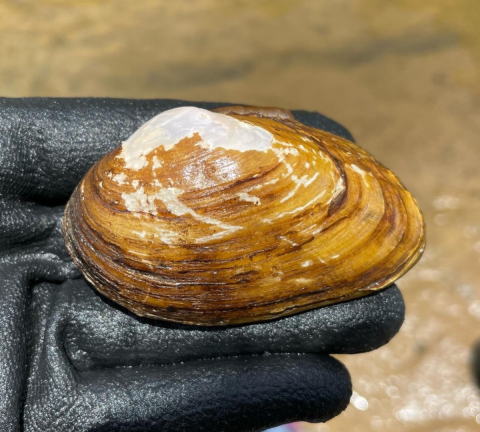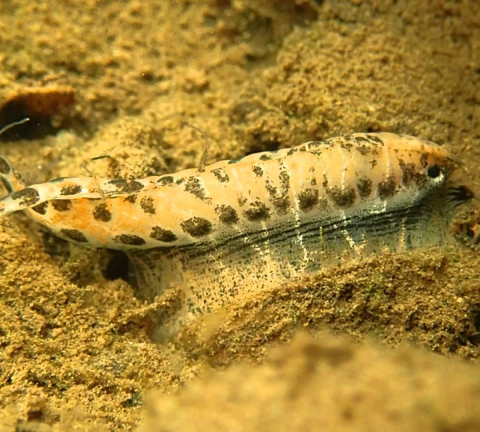Most moms will do just about anything to make sure their children survive and thrive, particularly in some of the harshest conditions. When the maternal instinct kicks in, moms go to work.
Mothers are adaptable, resourceful, and grateful to those who work with them to help their children through the journey of life. That’s especially true for moms who literally spend their entire lives underwater.
As families across the country celebrate Mother’s Day, freshwater mussels throughout the Southeast Region are busy, working to raise their little ones.
Like all parents, mussels spend a great deal of time preparing their young to take on their unique place in the world, explains U.S. Fish and Wildlife Service Biologist Brittany Barker-Jones, who leads recovery efforts for seven freshwater mussel species.
Baby mussels look like a tiny Pac-Man and are about the size of a grain of sand. As they grow, they play a large part ensuring water is clean and available. While they’re not readily visible, those who live, work, and play along waterways know when the mussels are present – and when they’re not.
“They are very important to our water systems. They are nature’s water filter, working constantly to keep our water clean,” said Barker-Jones who works in the Service’s Alabama Ecological Services Field Office. “They are busy filtering out dirty, suspended particles and algae from the river and depositing clean particles back on the bottom, much like a vacuum cleaner. They’re also indicator species, meaning they tell you a lot about water quality. Mussels are very sensitive animals. They are one of the first groups of animals to disappear when water quality starts to deteriorate. On the other hand, a diverse assembly of mussels usually indicates the water is clean.”
So, keeping freshwater mussels healthy and sending them on their way when the time is right is important. When they are adolescents, it’s time for mussels to move out on their own.
Mussels live a mostly sedentary life, so to get them where they’re going throughout streams and rivers, some mussel mamas need a little help, namely from a host fish. These fish act like a bus system, delivering baby mussels to other parts of the stream or river where they will live and work, filtering water.
To attract the host to take on their offspring and transport them to other locations, mama mussels have had to adapt. They have found clever ways to get their kids “on the bus,” so to speak.
Some mussels need a specific host fish; others are not as picky. Either way, mussel mamas use their charms to lure the hosts, making it easier for baby mussels to attach to fish transiting the waterways.
For example, bass eat smaller fish, so mussel mamas that require bass as a host, have modified shell tissue that moves in a way that mimics a minnow, which bass love. Once the bass is lured in close and takes a bite, the mussel’s marsupia, or “baby pocket,” bursts. The fish then acts just like a ride share, giving the babies now attached to its gills a ride upstream or downstream. This is important for distribution when an adult mussel may not move more than a few square feet on its own during its lifetime.
Then there are darters who feed on the bottom of the river, munching on insect larvae like mayflies, midges, blackflies, and caddisflies. To get darters’ attention, some mussel mamas will package their babies into lures that mimic their food sources. Sometimes, they attach these packages to rocks, sticks, or leaf litter, encouraging the fish to take a bite. When the fish clamps down on the suspect food, the mama’s package breaks, and the baby mussels burst out, attaching to their host.
Those are just a couple of examples of ways these moms cleverly reel hosts into helping disperse the junior mussels throughout the water system.
“They are awesome mamas. Their adaptability and creativity help keep the species alive. While they don’t have eyes, they have evolved different ways to attract their host fish over time,” says Barker-Jones. “Host fish are key to distribution of the mussels throughout our rivers and streams. They help spread out and distribute the mussels, so they aren’t as vulnerable to localized spills and other types of catastrophic events.”
The lure strategies, whether mimicking minnows, fish eggs, crawfish, or insect larvae, work throughout the Southeast Region, which Barker-Jones calls the “global hotspot” for native freshwater species.
There are approximately 300 freshwater mussel species found in the United States. Of the 97 species listed as threatened or endangered under the Endangered Species Act, 75 are found in the Southeast Region. Another 20 in the area are at risk.
Thanks in part to the Endangered Species Act, many mussel populations have bounced back, and numbers continue growing. For the last 50 years, the ESA has helped protect fish, wildlife, and plants listed by the Service as threatened or endangered. The Act, which celebrates its golden anniversary in 2023, outlines ways to add and remove species from the threatened and endangered lists; prepares and implements plans for their recovery; and allows for and facilitates interagency cooperation.
“Our streams and rivers have so much diversity. Just start at the bottom and work up. Each species has a unique role in the ecosystem, and they are all working together. Although out of sight and, most often out of mind, mussels are an important part of the greater circle of life. They perform a critical service that is essential to thehealth and well-being of our rivers, aquatic life, and humans. By conserving them, we help ensure the benefits they provide – and that we depend on – continue,” said Barker-Jones.
In addition to the ESA, in some southeastern states, funds from the Bipartisan Infrastructure Law Bipartisan Infrastructure Law
The Bipartisan Infrastructure Law (BIL) is a once-in-a-generation investment in the nation’s infrastructure and economic competitiveness. We were directly appropriated $455 million over five years in BIL funds for programs related to the President’s America the Beautiful initiative.
Learn more about Bipartisan Infrastructure Law help replace aging culverts with state-of-the-art structures that facilitate fish passage fish passage
Fish passage is the ability of fish or other aquatic species to move freely throughout their life to find food, reproduce, and complete their natural migration cycles. Millions of barriers to fish passage across the country are fragmenting habitat and leading to species declines. The U.S. Fish and Wildlife Service's National Fish Passage Program is working to reconnect watersheds to benefit both wildlife and people.
Learn more about fish passage . These efforts clear the way for host fish laden with mussels to transit waterways effectively and efficiently.
The Service’s National Fish Passage Program supports aquatic ecosystem restoration projects and restores free-flowing waters, allowing for enhanced fish migration. These projects also help mitigate the potential effects of climate change climate change
Climate change includes both global warming driven by human-induced emissions of greenhouse gases and the resulting large-scale shifts in weather patterns. Though there have been previous periods of climatic change, since the mid-20th century humans have had an unprecedented impact on Earth's climate system and caused change on a global scale.
Learn more about climate change by removing or bypassing natural and man-made barriers that could be problematic during flooding events. Fish passage projects improve safety conditions at bridges and river crossings as well.
These projects will help support the America the Beautiful initiative to conserve, connect and restore our nation’s lands, waters, and wildlife.
Like all parents, mussel mamas have outside forces influencing their young and impacting their parental efforts. Some of the challenges facing these aquatic parents are pollution, fish barriers, severe weather events, and society’s lack of awareness of who they are and what they do.
When bad weather hits or when it’s cold out, mussel mamas protect their babies by burrowing into the stream bottom, protecting them from the elements and sometimes going 10-12 inches deep
Barriers to fish passage – including built-up sediment, clogged waterways, dams, poorly constructed culverts, and litter -- are some of the biggest hurdles for these mighty mussels and their host fish. Most of the Southeast Region is private property, about 92 percent. This means that a preponderance of mussels live and work on private property. Barker-Jones explains that landowners who have partnered with the Service are critical to making sure mussels have the right conditions to live and work.
With the right conditions, which includes unimpeded fish passage, smaller mussels species can live up to 15-20 years. Larger ones may live to a 100 or more.
As she contemplates the role of freshwater mussels in the ecosystem, Barker-Jones says these mamas are definitely worthy of a Mother’s Day celebration.
Learn more about mussels.







